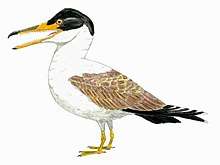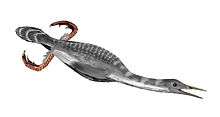Avialae
Avialae ("bird wings") is a clade of flying dinosaurs containing the only living dinosaurs, the birds. It is usually defined as all theropod dinosaurs more closely related to modern birds (Aves) than to deinonychosaurs, though alternative definitions are occasionally used (see below).
| Avialans | |
|---|---|
.jpg) | |
| Fossil specimen of Archaeopteryx lithographica | |
| Scientific classification | |
| Kingdom: | Animalia |
| Phylum: | Chordata |
| Clade: | Dinosauria |
| Clade: | Saurischia |
| Clade: | Theropoda |
| Clade: | Paraves |
| Clade: | Eumaniraptora |
| Clade: | Avialae Gauthier, 1986 |
| Subgroups | |
Archaeopteryx lithographica, from the late Jurassic Period Solnhofen Formation of Germany, is the earliest known avialan which may have had the capability of powered flight.[2] However, several older avialans are known from the late Jurassic Tiaojishan Formation of China, dated to about 160 million years ago.[3][4]
Definition
Most researchers define Avialae as branch-based clade, though definitions vary. Many authors have used a definition similar to "all theropods closer to birds than to Deinonychus."[5][6] A nearly identical definition, "the theropod group that includes all taxa closer to Passer than to Dromaeosaurus", was used by Agnolín and Novas (2013) for their clade Averaptora.[7]
Additionally, beginning in the late 2000s and early 2010s, several groups of researchers began adding the genus Troodon as an additional specifier in the definition of Avialae. Troodon had long been considered a close relative of the dromaeosaurids in the larger group Deinonychosauria, though some contemporary studies found it and other troodontids more closely related to modern birds, and so it has been specifically excluded from Avialae in more recent studies.[8]
Avialae is also occasionally defined as an apomorphy-based clade (that is, one based on physical characteristics). Jacques Gauthier, who named Avialae in 1986, re-defined it in 2001 as all dinosaurs that possessed feathered wings used in flapping flight, and the birds that descended from them.[9][10]
Differentiation from Aves
Gauthier[10] (page 34) identified four conflicting ways of defining the term "Aves", which is a problem since the same biological name is being used four different ways. Gauthier proposed a solution, number 4 below, which is to reserve the term Aves only for the crown group, the last common ancestor of all living birds and all of its descendants. He assigned other names to the other groups.
- Aves can mean all reptiles closer to birds than to crocodiles (alternatively Avemetatarsalia [=Pan-aves])
- Aves can mean those advanced archosaurs with feathers (alternatively Avifilopluma)
- Aves can mean those feathered dinosaurs that can fly (alternately Avialae)
- Aves can mean the last common ancestor of all the currently living birds and all of its descendants (a "crown group"). (alternatively Neornithes)
Under the fourth definition Archaeopteryx is an avialan, and not a member of Aves. Gauthier's proposals have been adopted by many researchers in the field of paleontology and bird evolution, though the exact definitions applied have been inconsistent. Avialae, initially proposed to replace the traditional fossil content of Aves, is sometimes used synonymously with the vernacular term "bird" by these researchers.[8]
Evolution
| |||||||||||||||||||||||||||||||||||||||||||||||||||
| Cladogram following the results of a phylogenetic study by Wang et al., 2016.[11] |
The earliest known avialan fossils come from the Tiaojishan Formation of China, which has been dated to the late Jurassic period (Oxfordian stage), about 160 million years ago.[8] The avialan species from this time period include Anchiornis huxleyi and Aurornis xui. Xiaotingia zhengi used to be considered a member, but was later classified within the clade Dromaeosauridae. The well-known early avialan, Archaeopteryx, dates from slightly later Jurassic rocks (about 155 million years old) from Germany. Many of these early avialans shared unusual anatomical features that may be ancestral to modern birds, but were later lost during bird evolution. These features include enlarged claws on the second toe which may have been held clear of the ground in life, and long feathers or "hind wings" covering the hind limbs and feet, which may have been used in aerial maneuvering.[12]
Avialans diversified into a wide variety of forms during the Cretaceous Period.[13] Many groups retained primitive characteristics, such as clawed wings and teeth, though the latter were lost independently in a number of avialan groups, including modern birds (Aves). While the earliest forms, such as Archaeopteryx and Jeholornis, retained the long bony tails of their ancestors,[13] the tails of more advanced avialans were shortened with the advent of the pygostyle bone in the group Pygostylia. In the late Cretaceous, around 95 million years ago, the ancestor of all modern birds also evolved a better sense of smell.[14]
See also
References
- Cau, A.; Beyrand, V.; Voeten, D.; Fernandez, V.; Tafforeau, P.; Stein, K.; Barsbold, R.; Tsogtbaatar, K.; Currie, P.; Godefroit, P. (2017). "Synchrotron scanning reveals amphibious ecomorphology in a new clade of bird-like dinosaurs". Nature. 552 (7685): 395–399. Bibcode:2017Natur.552..395C. doi:10.1038/nature24679. PMID 29211712.
- Alonso, P. D.; Milner, A. C.; Ketcham, R. A.; Cookson, M. J.; Rowe, T. B. (2004). "The avian nature of the brain and inner ear of Archaeopteryx" (PDF). Nature. 430 (7000): 666–669. Bibcode:2004Natur.430..666A. doi:10.1038/nature02706. PMID 15295597. Archived from the original (PDF) on 2006-02-09. Supplementary info
- Hu, D.; Hou, L.; Zhang, L. & Xu, X. (2009). "A pre-Archaeopteryx troodontid theropod from China with long feathers on the metatarsus". Nature. 461 (7264): 640–643. Bibcode:2009Natur.461..640H. doi:10.1038/nature08322. PMID 19794491.
- Liu Y.-Q.; Kuang H.-W.; Jiang X.-J.; Peng N.; Xu H.; Sun H.-Y. (2012). "Timing of the earliest known feathered dinosaurs and transitional pterosaurs older than the Jehol Biota". Palaeogeography, Palaeoclimatology, Palaeoecology. 323–325: 1–12. doi:10.1016/j.palaeo.2012.01.017.
- Weishampel, David B.; Dodson, Peter; Osmólska, Halszka (eds.) (2004). The Dinosauria, Second Edition. University of California Press., 861 pp.
- Senter, P (2007). "A new look at the phylogeny of Coelurosauria (Dinosauria: Theropoda)". Journal of Systematic Palaeontology. 5: 429–463. doi:10.1017/S1477201907002143.
- Federico L. Agnolín & Fernando E. Novas (2013). Avian ancestors. A review of the phylogenetic relationships of the theropods Unenlagiidae, Microraptoria, Anchiornis and Scansoriopterygidae. SpringerBriefs in Earth System Sciences. pp. 1–96. doi:10.1007/978-94-007-5637-3. ISBN 978-94-007-5636-6.
- Pascal Godefroit; Andrea Cau; Hu Dong-Yu; François Escuillié; Wu Wenhao; Gareth Dyke (2013). "A Jurassic avialan dinosaur from China resolves the early phylogenetic history of birds". Nature. 498 (7454): 359–62. Bibcode:2013Natur.498..359G. doi:10.1038/nature12168. PMID 23719374.
- Gauthier, J. (1986). "Saurischian monophyly and the origin of birds." In: K. Padian, ed. The origin of birds and the evolution of flight. San Francisco: California, Acad.Sci. pp.1–55. (Mem.Calif.Acad.Sci.8.)
- Gauthier, J., and de Queiroz, K. (2001). "Feathered dinosaurs, flying dinosaurs, crown dinosaurs, and the name Aves." Pp. 7-41 in New perspectives on the origin and early evolution of birds: proceedings of the International Symposium in Honor of John H. Ostrom (J. A. Gauthier and L. F. Gall, eds.). Peabody Museum of Natural History, Yale University, New Haven, Connecticut, U.S.A.
- Wang, M.; Wang, X.; Wang, Y.; Zhou, Z. (2016). "A new basal bird from China with implications for morphological diversity in early birds". Scientific Reports. 6: 19700. Bibcode:2016NatSR...619700W. doi:10.1038/srep19700. PMC 4726217. PMID 26806355.
- Zheng, X.; Zhou, Z.; Wang, X.; Zhang, F.; Zhang, X.; Wang, Y.; Wei, G.; Wang, S.; Xu, X. (2013). "Hind Wings in Basal Birds and the Evolution of Leg Feathers". Science. 339 (6125): 1309–1312. Bibcode:2013Sci...339.1309Z. CiteSeerX 10.1.1.1031.5732. doi:10.1126/science.1228753. PMID 23493711.
- Chiappe, Luis M. (2007). Glorified Dinosaurs: The Origin and Early Evolution of Birds. Sydney: University of New South Wales Press. ISBN 978-0-86840-413-4.
- Agency France-Presse (13 April 2011). "Birds survived dino extinction with keen senses". Cosmos Magazine. Archived from the original on 2 April 2015. Retrieved 11 June 2012.
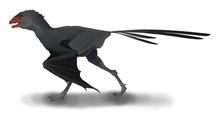

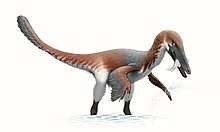
.png)



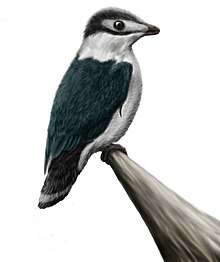

.png)

